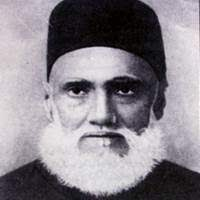Ismail Meerthi:
(1844–1917)
Maulvi Ismail Meerthi born on 12 November 1844 in Meerut, was an Urdu poet, Schoolteacher, and Educationist. He was home-schooled by his father Sheikh Piir Bakhsh., later he received his higher education in the Persian language from Mirza Rahim Baig, who replied Ghalib's Qati-e-Burhan by writing Sati-e-Burhan. At first Ismail was not interested in poetry but his contemporaries, especially Qalaq's companionship, attracted him to poetry. Initially, he wrote some ghazals which were published under pseudonyms. After that he turned to Nazms. Later, he had a long and strong acquaintance with Munshi Zakaullah and Muhammad Hussain Azad. And thus, his poems became popular in Urdu. Due to his ability and literary services, the government of the time gave him the title of "Khan Sahib".
Ismail Meerthi had a important place among those who introduced Urdu literature to modern Nazm-composition. The books written before the failed war of Independence in 1857 were on Social or Scientific sciences. The first books to tech Urdu to Children were written by 'Muhammad Hussain Azad' in Punjab and 'Ismail Meerthi' in Agra and Awadh, they were the first to compile the rules of Urdu grammar and syntax. But children’s literature is only one characteristic of Ismail Meerthi's personality. He is one of the Urdu poets who made the first formal experiments in modern Urdu poetry and wrote Ma'ari (free verse poems) . Although Azad and Hali are considered as the caravan of modern poetry, long before the historic mushaira held on April 9, 1874 under Anjuman-e-Tehreek-e-Punjab, Ismail and Qalaq had already written the foremost chapter of modern Urdu Nazm. Thus, it is wrong to consider Ismail Meerthi as a mere poet of children. His personality and poetry were multifaceted; whether it is children's literature, modern poetry or ghazal, qasida, masnavi, rubai, and other genres of speech. Ismail Meerthi has proved his mettle in every field. Ismail Meerthi's first collection of poems was published in 1885 under the title "Reza-e-Jawahar" in which many poems are translations of English poems.
The language of his poems is very smooth, decent and simple, while the thoughts are clear and pure. He was a Sufi, so his poems reflect religious tendencies. His chief object was to awaken a unconscious population, mentally, intellectually, and realistically, in tune with the changing national conditions. That is why he gave special importance to the mindset of children. He wanted the children not only to learn knowledge but also to be aware of their cultural and moral traditions.
After passing out from the Madrasa, Ismail joined a normal school. He had a keen interest in geometry. Apart from this, he also studied physical science and anatomy in this school. After completing his school, he enrolled in the Overseas course at Rurki College, but he did not like it and left it and returned to Meerut. At the age of 16, he joined the Education Department as a clerk. Meerthi was married to 'Bibi Naeem Al-Nisa', daughter of Sheikh Mehboob Bakhsh, in 1862. the couple had three sons and two daughters together He was appointed as a teacher of Persian in Saharanpur where he worked for three years and then returned to his old office in Meerut. In 1888, he was appointed as a teacher of Persian in the General Normal School, Agra. In 1889, he finally retired from there and settled in Meerut. During his tenure, he was offered the post of Deputy Inspector of Schools, but he refused, saying it would take a lot of travel. Maulana's health never agreed with him. Time and again he would complain of kidney pain and colic. Due to excessive hukkah consumption, he suffered from bronchitis as well. He died on November 1, 1917 at the age of 73 in Meerut.
مر چکے جیتے جی خوشا قسمت
اس سے اچھی تو زندگی ہی نہیں
Translation: Good luck living dead
Life is not better than this


Comments
Post a Comment